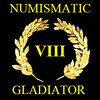Options
Excellent resource for ancients, incl. ancient Persia
I was just researching one of my coins (Sassanid dynasty, Kushro II drachm) online and found this very informative website complete with photos. The author does not allow reproduction without permission, and I can understand because he's clearly invested much time compiling the data. So instead of reposing I'm sharing a link!
Thought you might enjoy browsing.
Disclosure: he sells coins on the site, but this is not an endorsement of any kind. I did not buy mine from him, nor do I intend to buy (mine is nicer than what he has shown). I've never met him before to my knowledge ... unless he's a member of the forum? If YOU are the author than shoot me a PM!
Here is my coin ... struck at Ardeshir Khurra aka "Art" mint ...

Thought you might enjoy browsing.
Disclosure: he sells coins on the site, but this is not an endorsement of any kind. I did not buy mine from him, nor do I intend to buy (mine is nicer than what he has shown). I've never met him before to my knowledge ... unless he's a member of the forum? If YOU are the author than shoot me a PM!
Here is my coin ... struck at Ardeshir Khurra aka "Art" mint ...

0

Comments
Amat Colligendo Focum
Top 10 • FOR SALE
aren't these things paper thin?
DPOTD
I love the rich history behind this coin. So much happened in that region during the dynasty's reign. The map changed significantly at least three times.
My biggest question right now is regarding the name of the mint ... harasha perhaps you can shed some light ... I've seen "Art mint" called "Ardeshir Khurra" but I've also seen a monarch (pre-Sasanian, I believe) called Ardeshir I ... was the city named after him?
I haven't been able to find Ardeshir Khurra on any map from that period. Does anyone know whereabouts it's located? (possible answers are Iran, Iraq, Persia, Syria, Iberia, ... but where?)
Amat Colligendo Focum
Top 10 • FOR SALE
<< <i>It's thin by today's standards, yes but the process was very different back then. Were rim cracks common? >>
Yes. If the blob of metal being used for the planchet was too cool and/or too brittle, cracking was likely.
"Cracks" can also happen post-minting, in the process of excavation. I own a drachm much like yours that broke into two pieces when whoever dug it up tried to prise it out from (presumably) a fused lump of coins. Silver becomes brittle as it ages; an ancient or mediaeval silver coin is much more likely to shatter when stressed than a modern coin of similar size and thickness.
<< <i>My biggest question right now is regarding the name of the mint ... harasha perhaps you can shed some light ... I've seen "Art mint" called "Ardeshir Khurra" but I've also seen a monarch (pre-Sasanian, I believe) called Ardeshir I ... was the city named after him?
I haven't been able to find Ardeshir Khurra on any map from that period. Does anyone know whereabouts it's located? (possible answers are Iran, Iraq, Persia, Syria, Iberia, ... but where?) >>
As with Roman / Byzantine coins of the same time period, the mint-city on Sassanian coins is indicated by just a few letters - in this case, "ART". Unfortunately, due to a lack of records left behind by the Sassanians, we aren't entirely certain which letters were used for which city, and trying to work it out from first principles (linguistics, hoard evidence, etc) has proved difficult. I don't think there is full agreement on where "ART" was. Assuming it does indeed mean "Ardeshir", then the city referred to is the one now known as Firuzabad, Fars Province, Iran. King Ardeshir I was the founding monarch of the Sassanian dynasty and the ruined city of Gor was rebuilt by and renamed after him.
Roman emperor Marcus Aurelius, "Meditations"
Apparently I have been awarded the DPOTD twice.
Wow the history of that city is incredible ... You guys gotta click that link and read up ...
Amat Colligendo Focum
Top 10 • FOR SALE